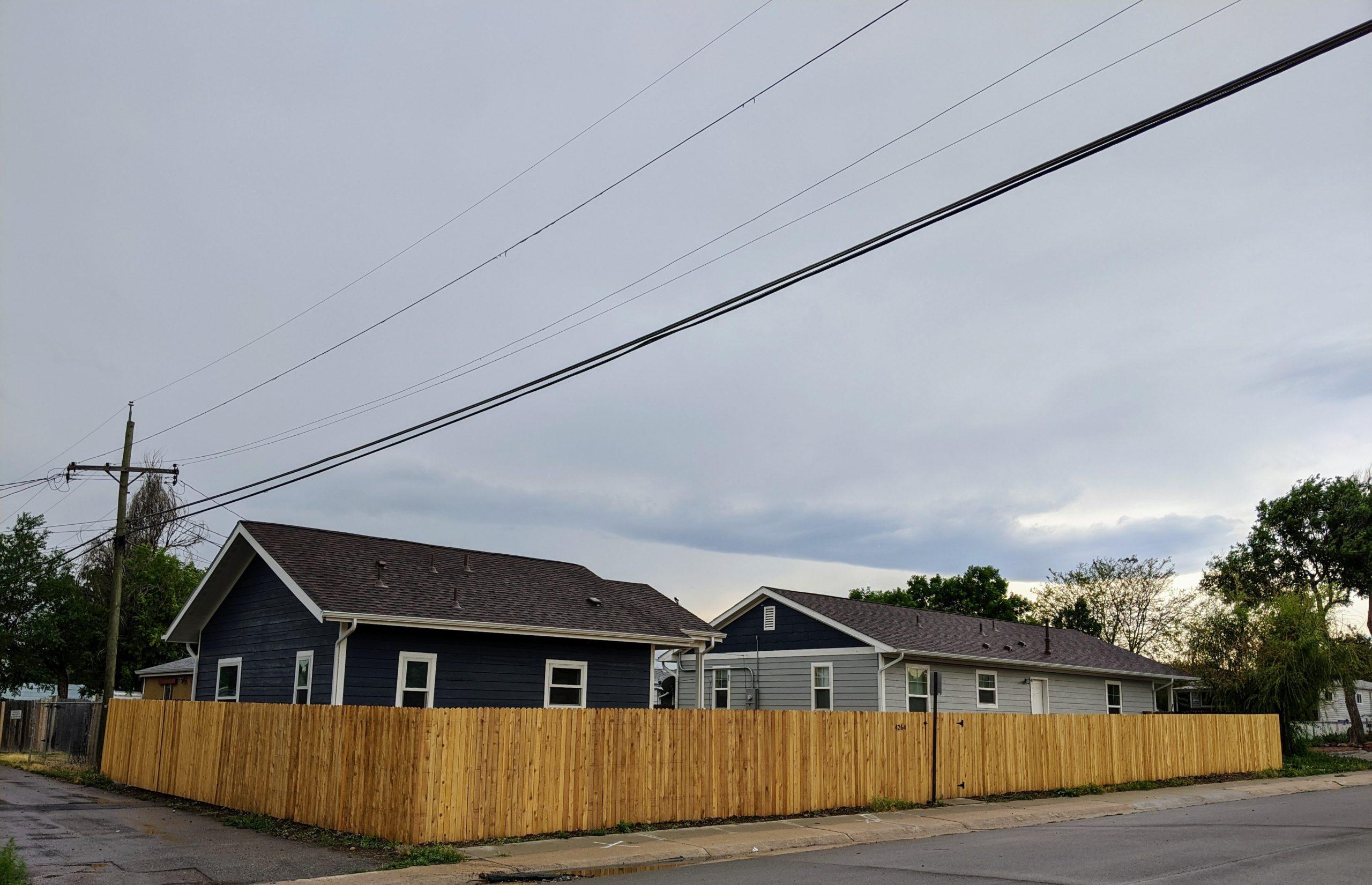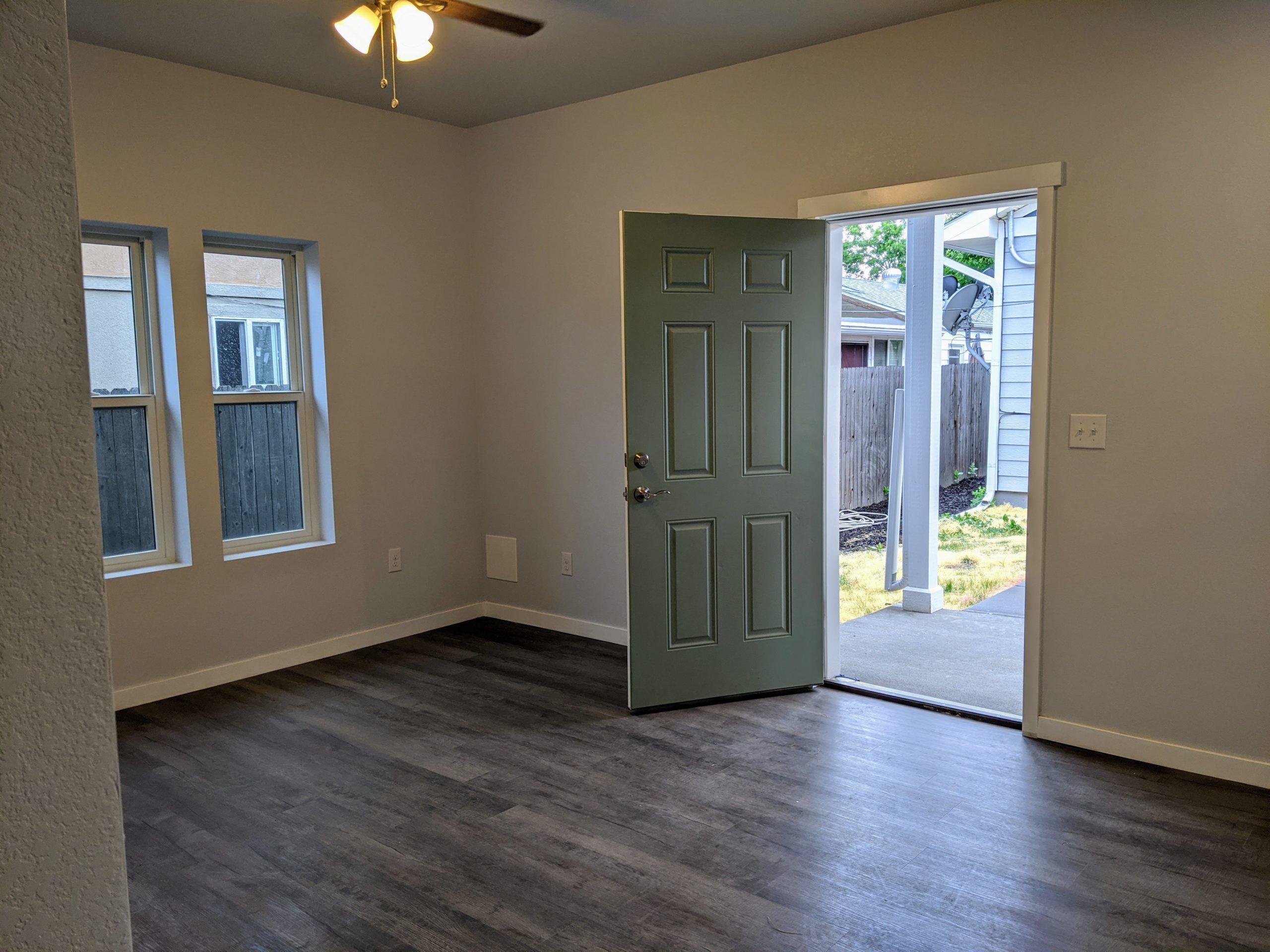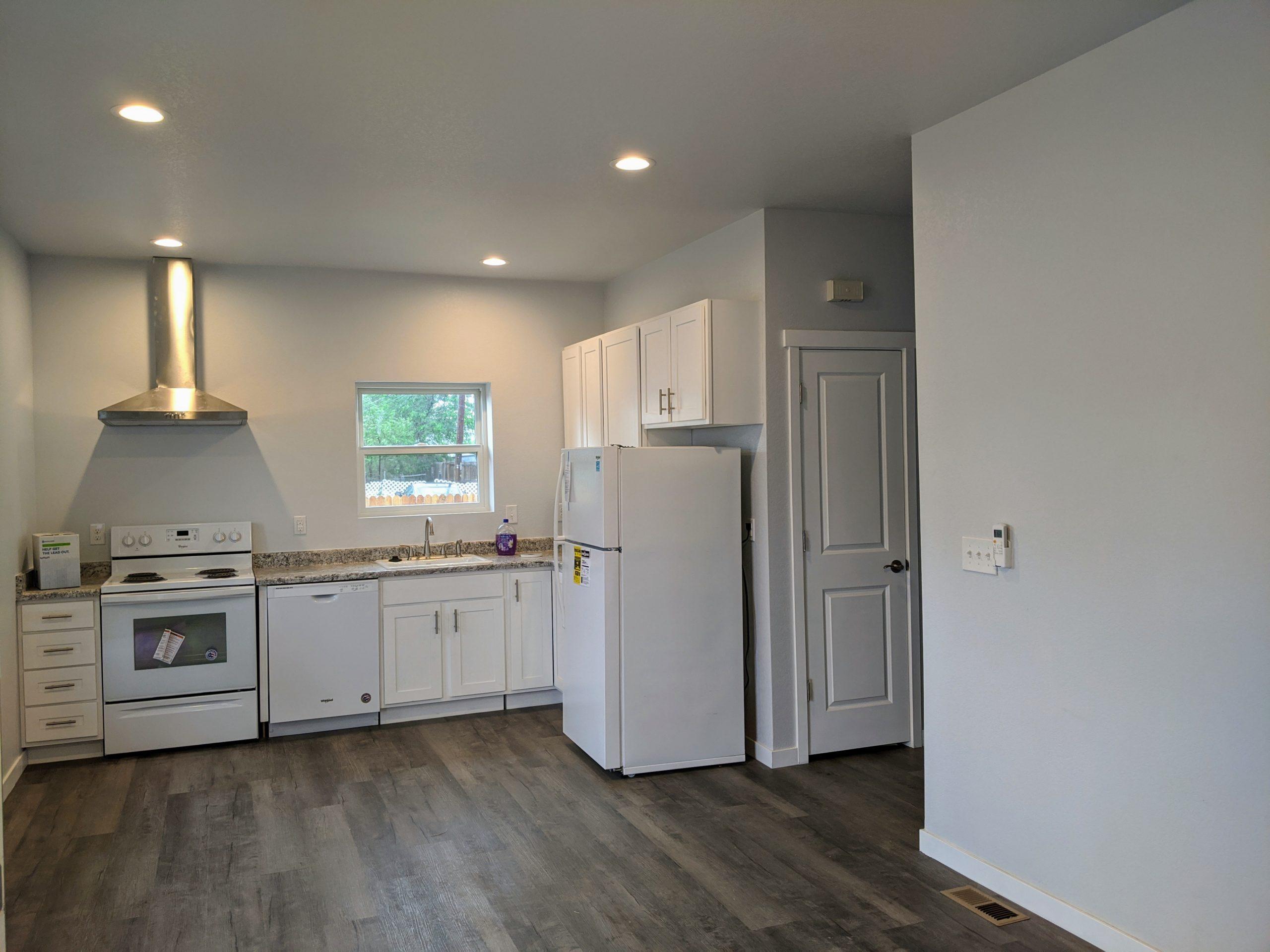It's easy to imagine daily life spilling from the well-lit living room, which is off an open kitchen, onto the comfortable front porch of a brand new cottage in Westwood.
The 450-square-foot one-bedroom, painted a dark blue-gray that goes well with the light gray of the larger home in whose backyard it sits, is the first to be completed as part of a project to use accessory dwelling units to promote housing stability and build wealth on Denver's west side.
Accessory dwelling units, known as ADUs, are also called granny flats, casitas or carriage houses. Renee Martinez-Stone, who leads the West Denver Renaissance Collaborative and its ADU project, has found in getting the first structure built that ensuring that the dwelling units are affordable can be a challenge. The lessons she's learned are changing the West Denver Renaissance Collaborative's approach, and could inform other efforts in a city that policy makers say needs more ADUs.
The first discussions of the west Denver ADU project began in 2016, and work began in earnest in 2018. Habitat for Humanity came on early as a design and construction partner. Habitat for Humanity, a nonprofit housing developer, helped create five designs for ADUs that have been approved by city building regulators and can be used by anyone in the program, saving architecture and some permitting fees. The designs are relatively cheap to build in part because they involve prefabricated elements.
Kate Hilberg, Habitat's director of real estate development, said the project's first ADU was designed to cost $113,000 to build. A total of about $30,000 was added to that because of issues encountered once construction began behind a four-bedroom house built in 2009 that was recently sold back to Habitat by a family that wanted to downsize.

Among the unexpected expenses, Hilberg said, were digging a crawl space and installing a watertight foundation, steps called for by an engineer after the soil was tested. One solution that would at least make the cost predictable is developing a universal foundation suitable to the local climate that could be used in all ADU project, the group determined. The West Denver Renaissance Collaborative has discussed that and other proposals with for-profit builders and others in the region who have experience with ADUs, Martinez-Stone said.
The collaborative is looking at ways to help low- and moderate-income families raise cash for the base costs and any surprises. Last year, Denver City Council approved a proposal to set up a $500,000 fund from which participants in the program can borrow to build ADUs. More recently, Martinez-Stone partnered with Elevation Community Land Trust. In the land trust model, the land under homes is owned communally and never sold, sparing homeowners a major cost. Participants in the West Denver project would have the option of selling their home and land to Elevation to raise cash, then buying back their home without the land and using the money left over to build an ADU.
Habitat will soon complete four other ADUs for the West Denver Renaissance Collaborative. The more ADUs that are built, the more practiced Habitat will be at predicting and overcoming building and design problems. Martinez-Stone is moving toward expanding the ADU project beyond west Denver, which would create opportunities to build more. She said the collaborative had not yet decided into which neighborhoods to expand, but that they would be those seen as vulnerable to gentrification and displacement, as is the case for the west Denver areas that are now part of the project.
"We need more housing," Martinez-Stone said.
The project has so far been restricted to households earning less than 120 percent of the area median income, currently $120,000 for a family of four. With the goal of getting more ADUs built in mind, some higher income earners will be allowed to participate. Details are being worked out, but it has already been determined that the higher earners would still be required, if they rent out the ADUs, to keep prices within reach of people earning no more than 80 percent of AMI, currently $78,500 for a family of four.
None of the initial five participants are planning to rent. Instead, their ADUs will allow them to house relatives. Amanda Sandoval, a city councilwoman who has championed ADUs, said that's not surprising. Sandoval said Hispanic families such as her own and those of many of her constituents in northwest Denver tend to be large and multi-generational. ADUs could allow aging parents to continue to live with, yet have some independence from, their adult children and their grandchildren, she said. Amid the pandemic, concern has grown about the safety of residential facilities for older people who are vulnerable to the worst affects of COVID-19, making the ADU option even more attractive, Sandoval said.
An ADU "provides opportunities for people to age, not necessarily in place, but with their family," she said.
This week, Sandoval formally proposed to Denver's Community Planning and Development Department that the Chaffee Park neighborhood in her District 1 be rezoned to allow ADUs. Usually such rezonings are requested one property at a time. The proposal to rezone an entire neighborhood was first brought to Sandoval by Chaffee Park residents and was the subject of a series of community meetings. Now, the proposal will be reviewed by Community Planning and Development, the Planning Board and City Council's Land Use, Transportation and Infrastructure Committee before being voted on by City Council. Sandoval said it could come to City Council for a public hearing and vote in October.
At that October meeting, city council members are likely to hear from the public concerns that were raised during Sandoval's initial community meetings in Chaffee Park. Parking was raised repeatedly, as were fears the neighborhoods could become too crowded.
Sandoval said she does not think ADUs will be built so quickly and in such large numbers that density will dramatically increase. As for parking, while homeowners may want to protect spaces along their streets, Sandoval pointed out that they have no claim to them. As a landlord herself, though not of an ADU, she said she has come to see that not every household will have multiple vehicles.
"The younger generations, I think they're learning no to have so many cars and be so car-dependent," Sandoval said.
Zoning now allows ADUs -- as long as the lots are big enough and the structures meet building requirements -- in 25 percent of Denver. That includes the neighborhoods where the West Denver Renaissance Collaborative started work. The latest Blueprint Denver, a policy document on how land should be used and transportation planned as the city grows, recommends taking steps to lower zoning and other barriers so that ADUs can be built throughout the city. Blueprint Denver portrays ADUs as a gentle way to add affordable housing options and as a possible "wealth-building tool for low- and moderate-income homeowners."


"A city-wide approach to enable ADUs is preferred," Blueprint Denver states.
Sandoval said one advantage of making ADUs possible throughout the city is that areas that are zoned for them would not draw speculative attention.
"We're not pushing up the land value anywhere, because it's everywhere," Sandoval said.
Sandoval has been focusing on her own district. She is not leading a push for a city-wide rezoning -- though she said the idea was intriguing. She said she is speaking to builders and to Martinez-Stone about why ADU development has not taken off to the extent many think it should.
Among the builders Sandoval has consulted is David Schultz, whose L&D Construction has built ADUs almost exclusively for three years.
"There's still lots of instances of us being not sure what's allowed," Schultz said of working with city officials.
Early last year, Schultz embarked on a project with homeowner Grant Swanson.
Swanson had moved to a Sunnyside house that's more than a century old and sits on a 7,800-square-foot lot. An extra little house out back offered flexibility, he said.
An ADU could be rented to a teacher or a nonprofit worker as a "small piece of social good," Swanson said. Or one day his wife's parents might move in. They are healthy and stably housed now, but "as people age, things could change," he said.
L&D estimated building a one-bedroom, one-bath, 750-square-foot apartment over a garage for Swanson would cost $350,000.
"Yes, it's a lot of money. Certainly if you break it down to a square foot basis, it's ridiculous," said Swanson, who works for a custom home builder.
He said he appreciated that L&D was straightforward about the cost and the possibility that unexpected issues could add expenses. Swanson went ahead with what he expected would be a a 12-month process, from brainstorming with an architect, through the city's permitting process and on to a completed apartment over a new garage off the alley that runs behind his lot.
Things went smoothly until the Department of Transportation & Infrastructure reviewed the plans and came back with a requirement that Swanson cede three feet of his property to widen the alley to 13 feet and repave the 62 feet of alley running along his lot. Repaving would add about $25,000 to the project,
"In an ideal world it would be great if this alley were wider. What makes absolutely no sense is that their requirement for us to cede this property and repave was not part of any existing larger plan to widen the entire alley," Swanson said. "It felt arbitrary."
"There is generally a pro-ADU sentiment in Denver right now among our elected officials," Swanson. "That did not filter down to the lower levels of decision-making, at least with regard to our little project."
Schultz, L&D's president, said he'd never before encountered an alley-widening request.
"When this happened, I got upset," Schultz said. "It's new, and it's just one more thing."
When the alley was raised, the project had the other city approvals it needed. L&D was within weeks of starting construction. After months of talks, a city transportation official withdrew the alley request.
"I think he finally agreed that it was an undue burden for these particular people," Schultz said. But by then, given the economic uncertainty sparked by the coronavirus, Swanson had decided to put his ADU on hold indefinitely.
Working with the city to remove undue barriers to ADUs is a new focus for Martinez-Stone. She hopes to look at such issues as lowering permit fees for participants in her program and allowing affordable housing developers to tap into a capital improvement fund for, for example, repaving sidewalks.
"It's really the (building) code that needs to change to unlock affordability," Martinez-Stone said.













